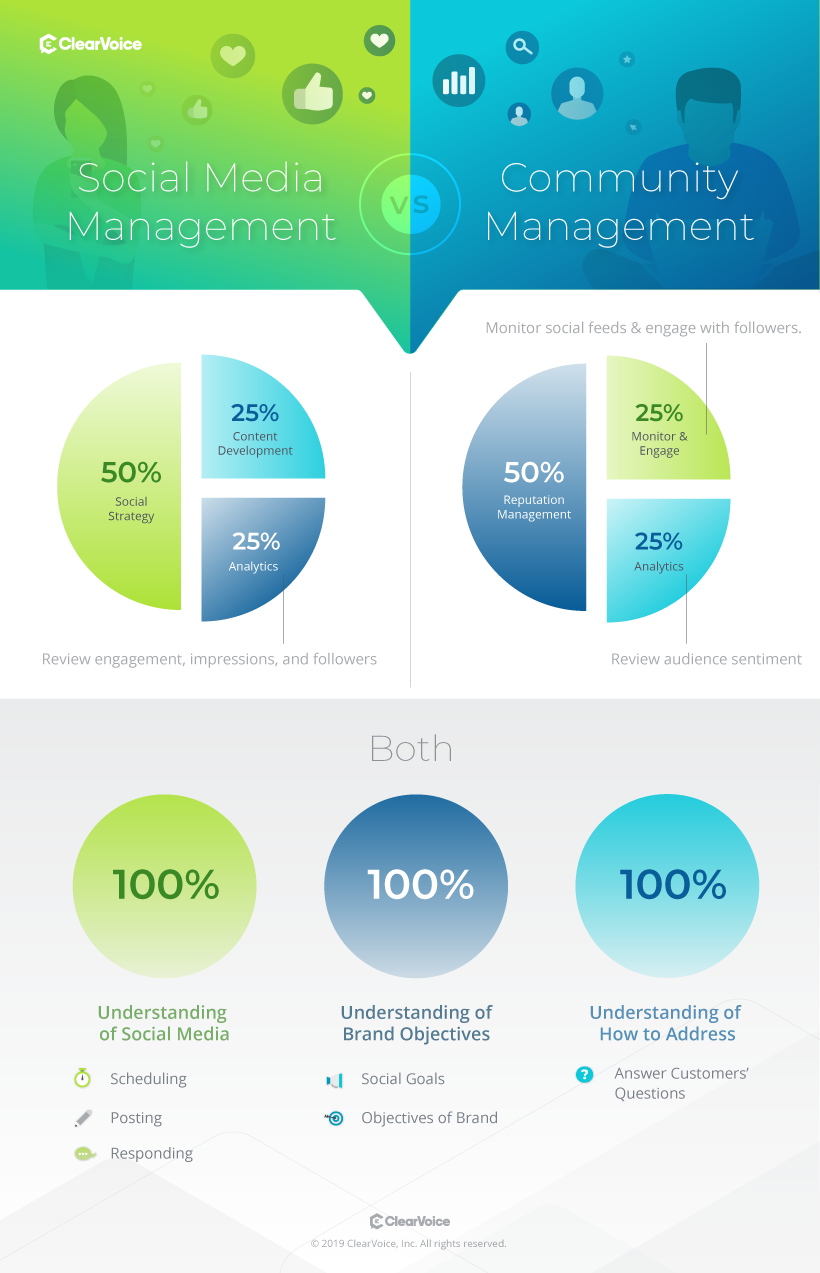When asked about the difference between community management and social media management, do you turn to Google or your in-house social media expert to help you answer this head-scratching question? Look no further, because the following blog (plus insightful infographic) will help you better understand the difference between the two.
Sure, community management is often included in social media management; however, that does not mean that they are one and the same. In this situation, it is important to allocate the right amount of resources for both; therefore, you are creating a content marketing strategy that will resonate with your audience across all social platforms.
What is community management?
Just like it sounds, community management is the active component of interacting with your community of followers, fans, and target audience across your social media platforms. This includes active listening, which is an important element of engaging with your followers to understand their wants and needs regarding your services.
Nowadays, customers reach out to brands via social media, hoping for a quick response or resolution to a problem. In fact, “an estimated 67 percent of consumers now use social media networks like Twitter and Facebook to seek resolution for issues.”
Community management is similar to customer service. As a brand/company, to ensure that your customers are satisfied, you must assist with resolving conflicts and providing ongoing solutions, which improves your overall brand reputation. Since “nearly 70 percent of consumers have said that they have used social media for issues to do with customer service on at least one occasion,” it is important to establish a community management strategy for your overarching brand.
Community management includes monitoring conversations across all your social platforms, engaging with your audience (either through a third-party app like Hootsuite, or natively within the platform), responding to messages and following potential new customers in a timely manner, and gauging the overarching sentiment of your company’s brand.
Lastly, community management contributes to content strategy, as well. Since they are customer-facing, community managers understand their followers’ wants and needs. For example, while you’re monitoring your beauty brand’s Facebook feed, a customer leaves a comment asking how to apply a particular face mask. Rather than just answering the question in your comments, you can use this idea to create engaging, shareable video content, such as a tutorial that showcases how to apply the face mask.
What is social media management?
While most community management strategies are focused on how to actively engage with your audience, social media strategy is focused on how to effectively distribute your content across all social platforms.
This includes understanding which social platforms to use, measuring analytics and building out a content marketing calendar, along with how to effectively convert your followers to leads via social.
Social media management is more focused on the overall brand strategy, such as how you distribute your content, what type of content you should be sharing with your audience and gauging their interest by reviewing metrics and social insights.
If you didn’t already know, “90 percent of brands use social media to increase brand awareness. But 58 percent of brands say measuring the effectiveness of social is a challenge, and only 34 percent measure social ROI.” Therefore, as part of your social media management, it is crucial to understand how to measure your social ROI to effectively continue building out your social strategy.
Along with community management responsibilities, social media management includes a small percentage of time spent monitoring social feeds. To understand brand awareness and insights, you are required to integrate community management into the development of an overarching brand strategy, as well. It requires collaboration with the team’s customer representative/support to better understand your target audience’s needs and how to distribute the content they would like to see on your social platforms.
What’s the difference?
Whether you are hiring a consultant, agency, or in-house social media manager, you must understand the difference between community management and social media management; therefore, you can split tasks accordingly.
Community management would fall under the responsibilities of a sales representative, reputation manager or customer service representative. The community manager must understand how social platforms work and how to monitor and actively listen on each social media platform to respond to critical matters effectively.
Social media management, on the other hand, would fall under the tasks and responsibilities of a social media manager. This individual actively builds out the social content strategy and publishes content across designated social media platforms. They need to have a thorough understanding of how each social media platform works and where to best reach a brand’s audience through social analytics.
The social media manager tracks engagement, impressions, follows and the overarching audience sentiment (with the help of the community manager), to better deliver content to targeted audiences.
By understanding the difference between these two roles, your company can better conquer each of these tasks and excel at both. Therefore, the responsibilities of community management and social media management are streamlined.
How to excel in both
Sure, a social media manager is also able to do community management; however, for community management to excel, you should allocate effective resources from your customer service representative to actively monitor and respond to tweets and comments (both positive, negative or neutral).
You might ask, “Why do I need to respond to positive comments, don’t you usually just address the negative?” On platforms such as Yelp, Glassdoor or Indeed, you can read both positive and negative comments regarding customer service.
To let your readers feel heard, thank them for their time in writing an honest review or providing feedback. Regardless of whether the feedback is positive or negative, let them know that you acknowledge what they have to say. Letting your followers feel heard is extremely important when you are establishing a strong customer and loyal follower base.
What to do next
Find a strategy that fuzes community management and social media management together. Each of these roles is important to help your business excel. One requires you to engage with your audience and network with your followers to build brand awareness, while another is focused on curating content and strategically finding ways to distribute your brand’s content across social.
Based on the infographic above, it is important to see where each percentage lies and how much effort needs to be allocated to each responsibility.
Remember that both community management and social media management are different and each one requires time and dedication to build out an effective plan. By being strategic with how you educate, engage and entertain your followers, you are building a content marketing strategy that will not only be beneficial to your target audience, but you are also delivering what their needs are by actively “listening” to their comments on your social posts.
Want some help?
Now that you know the difference between community management and social media management, it is time to start monitoring your feeds and building a strategic content marketing plan to be distributed on each social platform. If you need some help, don’t be afraid to work with a proven partner in the space. A content agency like ClearVoice can be a great cost-effective solution that maximizes the impact of your content strategy.
Connect with us today if that’s something you’re interested in.







